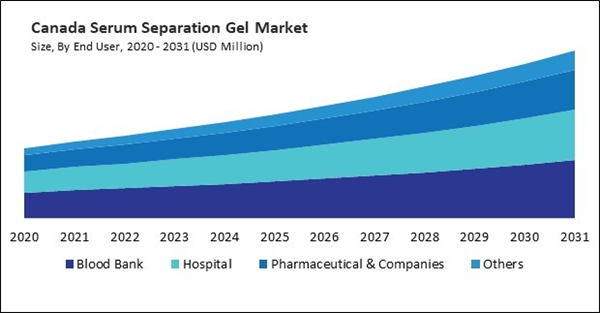The US market dominated the North America Serum Separation Gel Market by Country in 2023 and would continue to be a dominant market till 2031; thereby, achieving a market value of $3,108.5 million by 2031. The Canada market is experiencing a CAGR of 8.3% during (2024 - 2031). Additionally, The Mexico market would exhibit a CAGR of 7.4% during (2024 - 2031).
Laboratories increasingly adopt automated blood collection and processing systems, often incorporating serum separation technology. Automated platforms streamline sample handling, improve workflow efficiency, and reduce the risk of human errors. As the demand for high-throughput diagnostic testing grows, automated solutions for serum separation are becoming more prevalent in clinical laboratories and blood banks. Point-of-care testing devices that utilize serum or plasma samples are gaining popularity due to their ability to deliver rapid results at the patient’s bedside or in remote settings.
Additionally, Serum separation gel plays a role in enabling sample preparation for certain POCT devices, contributing to the accuracy and reliability of test results. The rising number of chronic diseases and the need for timely diagnosis and monitoring drive the demand for POCT devices and serum separation products compatible with these platforms.
According to the Centers for Disease Control and Prevention, six out of ten Americans suffer from at least one chronic condition, including diabetes, cancer, heart disease, or a stroke. The leading causes of death and disability in the US are these and other chronic disorders, dramatically raising healthcare costs. North America has a significant aging population, with a growing number of older adults experiencing age-related chronic conditions and comorbidities. Hence, the factors mentioned above will drive the regional market growth.
Based on Product Type, the market is segmented into Serum Separation Gel Integrated with Tube, and Serum Separation Gel Integrated without Tube. Based on End User, the market is segmented into Blood Bank, Hospital, Pharmaceutical & Companies, and Others. Based on countries, the market is segmented into U.S., Mexico, Canada, and Rest of North America.
List of Key Companies Profiled
- Becton, Dickinson, and Company
- F. Hoffmann-La Roche Ltd.
- Abbott Laboratories
- Agilent Technologies, Inc.
- Siemens Healthineers AG (Siemens AG)
- Bio-Rad Laboratories, Inc.
- Danaher Corporation
- Sysmex Corporation
- Charles River Laboratories International, Inc.
- QuidelOrtho Corporation
Market Report Segmentation
By Product Type- Serum Separation Gel Integrated with Tube
- Serum Separation Gel Integrated without Tube
- Blood Bank
- Hospital
- Pharmaceutical & Companies
- Others
- US
- Canada
- Mexico
- Rest of North America
Table of Contents
Companies Mentioned
- Becton, Dickinson, and Company
- F. Hoffmann-La Roche Ltd.
- Abbott Laboratories
- Agilent Technologies, Inc.
- Siemens Healthineers AG (Siemens AG)
- Bio-Rad Laboratories, Inc.
- Danaher Corporation
- Sysmex Corporation
- Charles River Laboratories International, Inc.
- QuidelOrtho Corporation
Methodology

LOADING...









